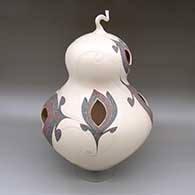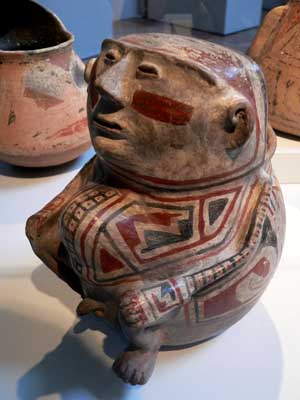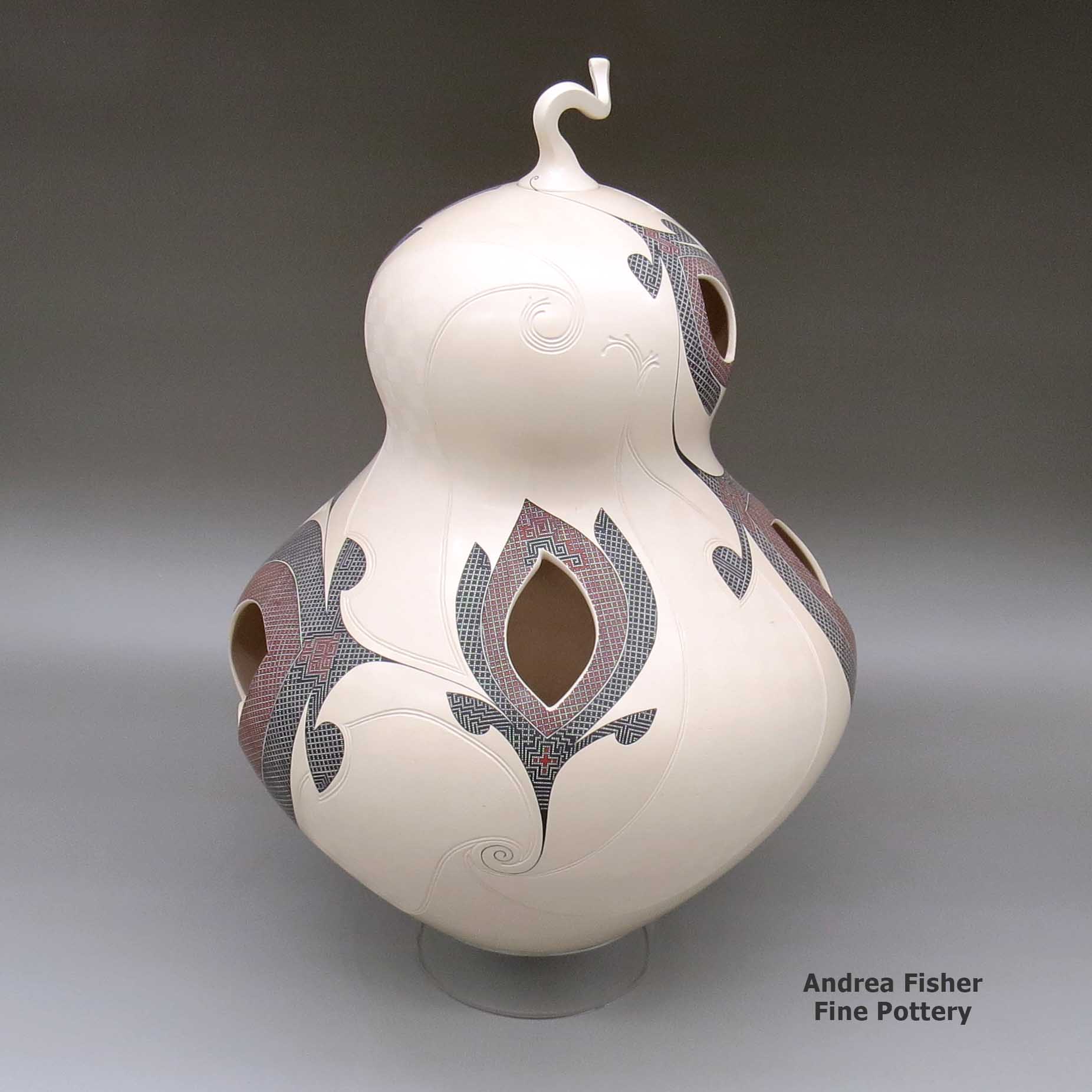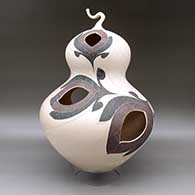
Diego Valles
Mata Ortiz and
Casas Grandes


Diego Gerardo Valles Trevizo learned the full range of Mata Ortiz shapes and styles, then struck out on his own in the direction of pure contemporary shapes decorated with stylized ancient designs. Some of his vessels are skeletonized, some undecorated, some with finely painted patterns that run parallel to the rims of his cutouts. His vision and the embodiment of that vision in his pieces is credited with expanding the boundaries of Mexican ceramics.
Diego came into this world in July, 1982 as the son of Diego Valles (deceased) and Angeles Trevizo. He says he made his first pot when he was about 8 years old and he's been hooked ever since. He counts Antonia Tena and Jesus Mora as his primary teachers. Despite becoming an electromechanical engineer, Diego is most proud of his accomplishments in ceramics, especially when he won the 2010 National Youth Award for Arts. He says accepting that award in person from then-Presidente Felipe Calderon was one of the proudest moments in his life.
Over the last couple decades Diego has traveled the world giving demonstrations and offering workshops about how he makes his pots. His works are shown in some of the finest ceramics museums in the world, like the American Museum of Ceramic Art in Pomona, CA, and the Nerman Museum of Contemporary Art in Overland Park, KS. He also participated in the first show organized by the Museo de Arte Indigena Contemporaneo (MAIC), managed by Espacias de Arte Nomada AC. That was a traveling exhibition that began in Montreal, PQ, Canada, then moved to Boston, New York, Washington, Austin, Ciudad Obregon, the Cabos, Riviera Maya and Mexico City.
Diego tells us his favorite shapes to work with are sculptural vases and his favorite designs tend to be in red and/or black. He says he draws his inspiration from the nature around Mata Ortiz and the culture of Paquimé. He also wants the world to know he believes in God.
Diego is married to fellow potter/engineer Carla Martinez and they have two beautiful daughters.
Among his other accomplishments:
- The Juan Quezada Celado Excellence Award at the 2023 Concurso Anual de la Ceramica de Mata Ortiz
- First ceramic artist to be Artist-in-Residence at Taliesin West, the Frank Lloyd Wright School of Architecture, Fall 2012
- People's Choice Award at the 2012 4th Biennial Concordia Continental Ceramics
- Proposed by the National Youth Institute as a candidate for the 2011 National Arts and Sciences Award
- First Prize at the Concurso Municipal de Cerámica in September 2011
- Best of Show at the 2010 3rd Biennial Concordia Continental Ceramics
- Best of Show at the 2009 Concurso Anual de la Cerámica de Mata Ortiz
- Best of Show at the 2008 Binational Painting Competition at the Museo de las Culturas del Norte y Zona Arqueológica de Paquimé
- First Prize at the 2006 Concurso Anual de la Cerámica de Mata Ortiz
100 West San Francisco Street, Santa Fe, New Mexico 87501
(505) 986-1234 - www.andreafisherpottery.com - All Rights Reserved

Mata Ortiz and Casas Grandes

The macaw pens at Paquimé
Casas Grandes is both a municipality and an archaeological district in northern Chihuahua State, Mexico. The archaeological district includes the pre-historic ruins of Paquimé, a city that began to build around 1130 AD and was abandoned about 1450 AD. Archaeologists are uncertain as to whether Paquimé was settled by migrants from the Mogollon/Mimbres settlements to the north or by Anasazi elite from the Four Corners region in the United States or by others. Over the years Paquimé was built into a massive complex with structures up to six and seven stories high with multiple Great Houses in the surrounding countryside. Today, the site is a UNESCO World Heritage Site.
Mata Ortiz is a small settlement inside the bounds of the Casas Grandes municipality very near the site of Paquimé. The fortunes of the town have gone up and down over the years with a real economic slump happening after the local railroad repair yard was relocated to Nuevo Casas Grandes in the early 1960's. The town was in steady decline until Juan Quezada, a poor farmer who gathered firewood in the area of the archaeological site, was inspired by fragments of ancient Paquimé pottery and even older fragments of Mimbres forms with bold black-on-white designs littering the ground to learn more.

Ramos Polychrome effigy pot from Paquimé
Quezada was successful in his quest to learn to recreate the ancient process using slightly more modern techniques (although no one in the present tradition uses a potter's wheel). He learned to use sand and other coarse materials for temper. He discovered that dried cow dung made an excellent and inexpensive firing fuel. Instead of using gourds for smoothing he substituted broken hacksaw blades. Instead of using yucca fiber brushes for painting he learned to make brushes with human hair. He persevered in his efforts and by 1971 had produced a kind of polychrome pottery. Since then, most pottery-making in the area has used innovations in the design and decoration of the pots but the materials and the basic crafting of the process have remained the same.
By the mid-1970s, Quezada had attracted a significant number of traders and his work was becoming a commercial success. That is when he began teaching his techniques to his immediate family. They in turn taught other family members, friends and the younger generations. Both women and men were included from the beginning.
Originally called Casas Grandes pottery in the early years of its production, the potters of this tiny village have made such an impact on the pottery communities, including many awards and special recognition from the Presidents of Mexico, that Mata Ortiz pottery is now becoming known around the world.
Today, pottery production has changed the village in many ways as there is now electricity, plumbing, vehicles and more for the residents. Virtually everyone in the small town (2010 population: 1,182) makes their living by working in some part of the pottery-making process, from potters to clay-gatherers to firewood collectors to traders.
Mata Ortiz pottery incorporates elements of contemporary and prehistoric design and decoration, and each potter or pottery family produces their own distinctive, individualized ware. Young potters from surrounding areas have been attracted to the Mata Ortiz revival and new potting families have developed while the art movement continues to expand. Without the restraints of traditional religious practices or gender constraints, a vibrant flow of new ideas has enabled the pottery of Mata Ortiz to avoid the derivative repetition common to virtually all folk art movements. This blend of economic need, gender equality, cultural expression and artistic freedom has produced a unique artistic movement in today's community.
Lower photo is courtesy of David Monniaux, Creative Commons Attribution-Share Alike 3.0 Unported License
100 West San Francisco Street, Santa Fe, New Mexico 87501
(505) 986-1234 - www.andreafisherpottery.com - All Rights Reserved


Diego Valles, Mata_Ortiz_and_Casas_Grandes, Largepolychromeliddedgourd-shapedjarwithorganiccut-outdetails,asgraffitoandpaintedcuadrillosandgeometricdesign,andamatchingstem-shapedlid
Mata Ortiz and Casas Grandes
$ CALL
dtcg3c251
Large polychrome lidded gourd-shaped jar with organic cut-out details, a sgraffito and painted cuadrillos and geometric design, and a matching stem-shaped lid
14 in L by 14 in W by 21.25 in H Measurement includes stand
Condition: Excellent
Signature: Diego G Valles T. Diego G Valles T., with copyright symbols and date
Date Created: 2018
100 West San Francisco Street, Santa Fe, New Mexico 87501
(505) 986-1234 - www.andreafisherpottery.com - All Rights Reserved

Genovevo Sandoval Family Tree
Genovevo Sandoval lived from 1864 to 1950. His first wife was Paula Gutierrez and she lived from 1885 to 1925. After Paula passed on, Genovevo married Josefa Trevizo (1908-1973). Many potters from the Mata Ortiz area are descended from Genovevo and his two wives.
Disclaimer: This "family tree" is a best effort on our part to determine who the potters are in this family and arrange them in a generational order. The general information available is questionable so we have tried to show each of these diagrams to living members of each family to get their input and approval, too. This diagram is subject to change should we get better info.
-
Genovevo Sandoval (1864-1950) & Paula Gutierrez (1885-1925)
- Marco Sandoval & Jesusita Rodriguez
- Eduviges Vicki Rodriguez & Salbador Ortiz (d. 1997)
- Paty Ortiz & Cruz Santillan
- Eduviges Vicki Rodriguez & Salbador Ortiz (d. 1997)
- Angel Sandoval & Maria
- Socorro Sandoval & José Silveira
- Lila Silveira & Carlos Carillo
- Saul Silveira & Sulma Orozco
- Yadira Silveira & Roberto Olivas
- Trinidad Trini Silveira
- Alondra Silveira
- Gustavo Silveira
- Socorro Sandoval & José Silveira
- Julia Sandoval & Francisco Valles
- Diego Valles Sr. & Angela Trevizo
- Diego Valles Jr. & Carla Martinez
- Armando Valles & Nayeli Perez
- Diego Valles Sr. & Angela Trevizo
-
Genovevo Sandoval (1864-1950) & Josefa Trevizo (1908-1973)
- Reyes Sandoval
- Monserrat Sandoval & Rojelio Silveira
- Julio Cesar Silveira
- Joel Silveira
- Rafael Silveira
- Israel Silveira
- Dolores Lola Sandoval & ? Carrillo
- Carlos Carrillo & Lila Silveira
- Monserrat Sandoval & Rojelio Silveira
- Antonio Sandoval & Refujio Mendoza
- Celia Sandoval & Felix Ortiz
- Macario Ortiz
- Raquel Ortiz & Chester Ortiz
- Sofia Sandoval & Roberto Beto Tena
- Gerardo Tena & Norma Hernandez de Tena
- Gerardo Tena Jr.
- Mariela Tena
- Melissa Tena
- Adolfo Fito Tena
- Gerardo Tena & Norma Hernandez de Tena
- Maria Jesus Sandoval & Aureliano Ortiz
- David Ortiz & Anastasia Mancino
- Luiz Ortiz & Maricela Olivas
- Jesus Maria Sandoval & Juan Mora Sr.
- Olivia Mora Sandoval & Armando Rodriguez
- Abraham Rodriguez
- Luis Armando Rodriguez
- Juan Mora Sandoval
- Julio Mora (1971- ) & Alma Soto (1974- )
- Lucia Mora
- Anastacio Mora
- Antonia Mora
- Olivia Mora Sandoval & Armando Rodriguez
- Genoveva Sandoval & Nicolas Silveira
- Armando Silveira & Tomasa Mora
- Arminda Silveira
- Octavio Tavo Silveira & Myrna Hernandez
- Jesus Octavio Silveira
- Octavio Silveira
- Silvia Silveira & Tomas Ozuna
- Lazaro Ozuna
- Veronica Silveira & Sabino Villalba
- Tomasa Silveira
- Eusebio Chevo Sandoval & Esperanza Tena
- Cesar Sandoval
- Dora Sandoval
- Ismael Sandoval
- Celia Sandoval & Felix Ortiz
(505) 986-1234 - www.andreafisherpottery.com - All Rights Reserved



